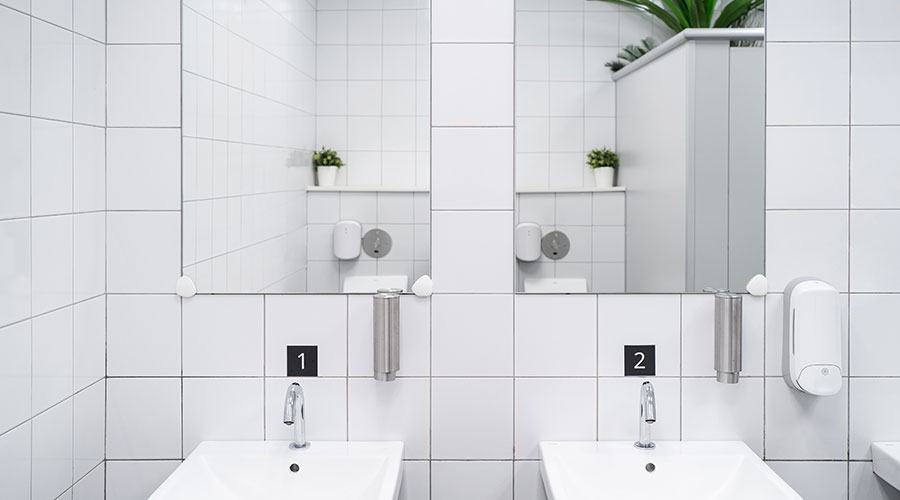Saving (and Going) Green with Copper
Copper’s benefits can enhance the performance of key equipment, including motors and HVAC systems
Energy savings. Responsible materials use. Dependable performance. Reduced downtime. These benefits are probably close to the top of the wish lists of most engineering and maintenance managers when specifying products.
To help make these wishes come true, managers should consider the often-hidden assets of copper components in the products they specify, install and maintain, both in new construction and retrofits. Copper plays a central role in motors, transformers, wiring and grounding.
Plumbing, especially fire-sprinkler systems, gas-distribution and HVAC systems, also can benefit from including copper. Perhaps surprisingly to many, recent studies show copper also has natural antimicrobial properties.
The challenge for managers is to find the right product applications in which copper can cost-effectively deliver benefits to their organizations.
Motors
A motor’s first cost isn’t always its lowest cost. Annual operating costs can be several times the purchase price, so even a small improvement in electrical efficiency can make a major difference. Compare a 25 horsepower (hp), 1,800-rpm, 460-volt (V) standard-efficiency motor to a comparable NEMA Premium motor, as in this Motor Efficiency Comparison chart.

Working at 75 percent load for 6,000 hours, the NEMA Premium motor, with only about 1 percent greater efficiency, saves 958 kilowatt hours (kWh) annually. To calculate annual energy cost savings, multiply that figure by the cost per kWh.
Factoring in the incremental cost between the two motors of $96 can quickly produce the payback period. At $0.07/kWh, that is less than 11⁄2 years, and it results in a $67 annual dividend over the motor’s life.
Higher levels of copper in stator windings reduce I2R losses, resulting in greater efficiency and cooler operation, which often means longer life and greater dependability.
Transformers
Copper also can make a major difference in transformer performance. Aluminum’s electrical conductivity is about 62 percent that of copper on a volume basis; aluminum weighs less because of its large density difference. On the other hand, copper-wound transformers are smaller.
Aluminum’s volumetric conductivity and its strength are much lower than those of copper, so an aluminum transformer that matched the kVA rating of a 400-MVA copper unit, for example, would be huge — adding to the cost of transportation and installation, as well as requiring more space.
Although aluminum-wound transformers can be less expensive initially, the difference is relatively small for medium and large units. In this size range, the winding’s cost has very little to do with the overall cost of the finished transformer.
What matters is connectivity, especially the durability of internal connections. The transformer will be damaged if connections don’t remain tight and free of corrosion. Copper connections stay tighter and don’t suffer corrosion problems.
One often-overlooked point when requesting quotes for a new transformer is the importance of asking bidders to provide load and no-load losses, along with the usual price and delivery information.
The results of a total-ownership-cost (TOC) analysis show that the lowest TOC transformer compared with the lowest first-cost transformer yielded an estimated return on investment of 156 percent.
Viewed another way, the simple payback period in purchasing the lowest-TOC transformer was only seven months. Compared with the lowest-first-cost transformer, the high-efficiency copper-wound transformer literally pays for itself in energy cost savings.
Wiring
Upsizing even common branch circuit wiring can generate significant energy savings and lower operating costs. Consider a 100-foot, single-phase branch circuit with a 15 A lighting load operating 4,000 hours annually.
Upsizing from #12 to #10 AWG copper wire will save 116 kWh per year because the load loss for #12 AWG is 77W at 40 degrees Celsius, or 308 kWh/year. The load loss for #10 AWG is 48W at 37 degrees Celsius, or 192 kWh/year.
For just one branch, the savings amount to $8.70 per year, based on a cost of $0.075/kWh. Again, these savings are the result of reduced I2R losses. And the upsized, cooler-operating wiring also provides greater flexibility in handling future load changes.
Power Quality and Grounding
The proliferation of computers and other sensitive devices throughout facilities has fostered the need to design buildings’ electrical systems with an eye on power-quality issues.
Poor power quality can hamper the reliable operation of computers and computer-based equipment found in nearly every kind of facility. Often, the loss of productivity resulting from computer equipment failure, miscalculations and downtime is more important than the physical effect on the equipment. In fact, estimates put the total annual cost of lost productivity to U.S. businesses at $15-30 billion.
A survey by E-Source indicates that, while most respondents did not calculate the cost of their annual losses from poor power quality, roughly one-third of those reporting a loss say it exceeded $1 million. Some, however, might have erroneously attributed power-quality glitches to software or hardware causes.
Obviously, it is imperative to keep transient over-voltages and high-frequency harmonics away from microcircuits. Installing enhanced electrical systems and better grounding systems often can solve the problem.
Grounding can be a major cause of downtime and lost productivity, not to mention safety-related problems. So completely grounded buildings, equipment, equipment cabinets and building wiring with a system resistance of 5 ohms or less is critical to dependable operation. Deeply buried copper electrodes, along with halo and ring grounds, all firmly bonded to heavy copper grounding conductors help prevent equipment damage, and they protect against the multiplied costs of downtime.
Plumbing
Managers should consider copper tubing as an economical and dependable component in automatic fire-sprinkler systems and gas-distribution systems.
Copper-plumbed sprinkler systems are the most cost-effective solution in many situations, especially where quick installation, small size and clean operation meet critical needs. Copper-tube systems are easily fabricated on-site. Due to their small size, they can be easily installed in concealed locations and are less obtrusive.
Copper systems also deliver clean, rust-free, uncolored water when activated, which can mean a major difference in property damage when the system goes off. For fuel gases, semi-rigid or flexible copper tube can be installed quickly anywhere with few joints and, again, is easily concealed.
With more than four decades of use, copper gas systems have proven highly dependable, especially for today’s high-pressure systems. Copper for gas distribution also usually ranks as the lowest-installed-cost system. As with sprinkler systems, a copper system often is easier to maintain over its service life.
HVAC Systems and IAQ
Along with its electrical conductivity, copper’s thermal conductivity — in HVAC systems, as well as in other heating and cooling applications — is an industry benchmark. Using copper for coils, tubes and fins can deliver greater energy efficiency and longer service life.
Also, it is well known that many HVAC systems harbor notorious bacteria and fungi because their dark, moist environments are conducive to the growth of biological films that affect indoor air quality (IAQ).
Proper maintenance of HVAC systems to remove the build-up of such pathogens can be costly. Whether using disinfectants or ultraviolet light, the problem is significant, and methods to control it in some cases are not completely effective.
Recent studies by the University of Southampton in the United Kingdom have demonstrated the effectiveness of copper copper alloys’ antimicrobial properties. Laboratory studies on several pathogens, including Aspergillus niger and methicillin-resistant staphylococcus aureus (MRSA), show that they die within hours on copper alloys.
They can continue to thrive for days, however, on stainless steel, aluminum and plastics. Other studies have shown copper’s efficacy in stemming the growth and spread of Legionnella pneumophilia, the cause of Legionnaires’ Disease.
These studies suggest that using copper components in HVAC systems can prevent the formation, breeding and spread of these harmful organisms and, as a result, prevent the contamination of airflow to occupied areas served by these systems.
Ken Geremia is communications manager for the Copper Development Association — www.copper.org
Spotlight: Copper Development Association
The Copper Development Association (CDA) is the market development, engineering and information services arm of the copper industry. CDA has a rich history of serving the industry, its member companies, their customers and all end users of copper and copper-alloy products. Among its services and resources and activities are these:
-
Technical service to end users. CDA’s technical publications and its industry-experienced professional staff are resources for this advisory service.
-
Copper Data Center. The enter is available free through CDA’s web site and provides access to the technical literature on copper and its alloys. CSA Illumina evaluates and indexes, reports and articles from around the world for CDA. Abstracts are available online and full articles may be ordered.
-
Design, product and technical publications. CDA has a library of some 250 publications, including case studies, technical references and guides, videotapes and CD-ROMs, to make it easier for customers, industry engineers and purchasing managers to select and apply products.
-
Market data. CDA compiles annually a 20-year tracking of U.S. copper supply and key market consumption.
-
For more information on CDA’s activities and resources, visit www.copper.org.
— Ken Geremia
|
Related Topics:












